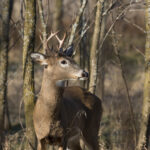November is the month that deer hunting, and everything that goes along with it, starts taking center stage in the lives of many folks in the Northland. The main goal of all this activity is a freezer full of venison, but the benefits can be far greater than simply having meat on hand.
From a nutritional perspective, venison is a stand-out. It’s lean and a good source of protein, with 9 grams per ounce. That’s more protein than the same amount of beef, but with about one-fifth of the fat, and what fat venison does have is largely unsaturated. It’s a source of thiamine (B1), riboflavin (B2), niacin (B3), iron, Vitamin K, Omega-3 fatty acids, and zinc.
Deer hunting is a great opportunity for physical activity. Walking long distances over uneven terrain absolutely counts as the “moderate to vigorous-intensity aerobic activity” recommended by the CDC. Since hunting, field dressing, and processing deer requires stamina, strength, and good balance, it’s in a hunter’s best interest to go into the season as fit and strong as possible. Keep up the aerobic workouts, resistance training, and balance exercises throughout the year, so that when hunting season starts, you’re ready to go.
Hunting provides mental and emotional workouts too. Planning, coordinating details of the hunt, and staying current with changing rules all require sharp thinking before the sharp shooting can start. Emotional control is a skill that can be developed in the deer blind. Learning to calm the body and mind when “buck fever” (racing heart, nerves, shaking hands) strikes has benefits far beyond hunting season.
Spending time outdoors can also reduce feelings of depression, lower blood pressure, and diminish levels of stress. Spending time with others can strengthen social ties and provide connection to family and cultural traditions. Conquering tough terrain, managing uncomfortable temperatures, and outlasting inclement weather all take grit. Missing a shot, learning to accept that reality, and planning ways to improve chances of success for next time are all skills of resilience.
Here are some additional tips to keep you safe and healthy this hunting season:
Take steps to prevent falls. Falls can easily happen if the stand has deteriorated, or when a hunter is in a tree stand and is startled by an animal. The average fall distance from a tree stand is 15 feet. Injuries sustained from that height can be severe or even deadly. Check equipment integrity, use safety belts, and stay aware of your surroundings.
Avoid alcohol, marijuana, and other drugs. This includes some prescription and over-the-counter drugs. They all diminish hunters’ ability to make quick, safe decisions and make them more susceptible to injuries like frostbite and hypothermia.
Let someone know where you’ll be hunting. Two-way radios are a good idea or at least carry loud whistles. It’s important that someone be able to locate you if needed.
Be CWD aware. Chronic Wasting Disease is an always-fatal brain disease that affects deer, elk, and moose. While there is currently no evidence that humans can be infected from eating contaminated meat, it is safest to avoid that possibility. Do not eat meat from animals that appear thin or sick, or animals exhibiting unusual behavior. Take precautions when field dressing and processing deer, and consider having your deer tested. Learn more about Chronic Wasting Disease at: mndnr.gov/cwd.
Brush up on your basic first aid and follow the rules of firearms or archery safety:
- Treat every firearm or bow as if it’s loaded.
- Always keep the gun or bow pointed in a safe direction.
- Keep your finger off the trigger until you’re ready to shoot.
- Keep the gun unloaded until ready to use.
- Be positive of your target—what’s in front of it, near it, and beyond it. If you’re not sure about any one of these, don’t shoot.
- Protect your ears and eyes with safety glasses and hearing protection.
- Remember to wear blaze orange so that others can see you.
Treat venison with the same care you would any other raw meat. Wrap or seal to keep the juices from contaminating other foods. Keep it cold, 41°F (5°C) or colder. Use within a couple of days. Wrap tightly when freezing and thaw safely.
Cook to safe temperature: whole cuts to a minimum internal temperature of 145°F (63°C) and ground to a minimum of 165°F (74°).
Use as you would beef: steaks, roasts, ground, jerky, sausage, etc.
Deer hunting is an important tradition in many peoples’ lives, and the benefits can extend far beyond what’s on the plate.




